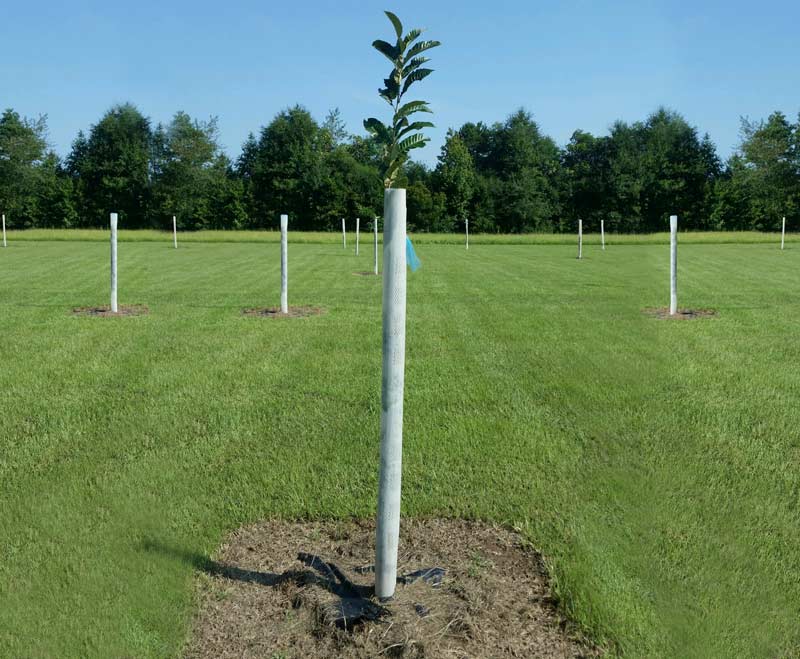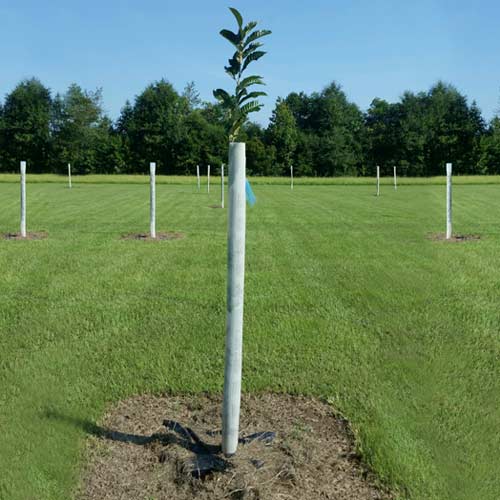by Allen Deese
With hunting season approaching, many of you have already planted your food plots or are preparing to do so. It’s also a great time to plan to add trees to your property this winter. As we are prepping our land and bushhogging, we often find areas that we constantly mow and can’t seem to decide what to do with it. It’s these areas that I would concentrate on getting some small orchards of mast-producing trees started. At our nursery, we’ve worked extremely hard all year to provide you, the landowner, with the best quality seedlings and trees. My hope is the following article will help you plan, plant, and care for your trees because we take great pride in providing you with great trees and information. If you are not successful at growing trees, then we are not doing our job. The only way any nursery can be successful is if the customer is successful. We all need to plant more trees, and I need you to be successful, so you return and purchase more. Or at least tell someone how successful you were so that they will plant also. Below is a brief guide that will help you be more successful with your plantings.
Whether you have container trees or bare-root seedlings delivered to you or you visit a nursery and pick out your trees, here is an excellent guide to go by on what to look for:
- Look for healthy one-year-old whips 3′ to 4′ tall, ½” to ¾” in diameter fruit trees
- For oak or other trees that are grown from seed, look for 12″- 36″ saplings
- Plants grown in pots should be 4′ to 8′ tall and 1″ to 2″ in diameter
- Closely check labels to make sure of variety and rootstock on fruit trees
- Select trees that will grow in the soils that you have, wet, upland dry, alkaline all are significant and tree specific

Seedling Care
When you receive your trees, be sure to pay special attention when handling your plants that you not allow the roots to dry out. Planting dates are fall, winter, and spring if you have to. We do not suggest any plantings during the summer months unless you plan to water them regularly. Plant your seedlings as soon as you can upon receiving them. If you plan to plant your seedlings within one week of receiving, you can leave them in the original package and store them in a cool place out of direct sunlight. Check the roots every couple of days to make sure they are moist, do not allow the seedlings to freeze or be left in an area that could get too hot. If you feel moisture could be a problem, wet some paper towels or newspaper and wrap around the roots in the box to retain moisture.
Another way to store your seedlings is to heel them in; this works well for longer storage. Dig a trench in the ground deep enough and wide enough to insert the bundle of seedlings roots into the ground and cover with soil. Next, you would want to water the ground to settle the soil and to keep them moist. Water the seedlings at least once a week unless you have had adequate rainfall. The seedlings will keep much longer this way, and you can remove and plant as needed. Before planting, I like to soak the roots in some water for a couple of hours to hydrate the root system.
Site and Soil Requirements
If you are planting fruit trees, sunlight is the key ingredient in maximizing fruit production. Early morning sun is ideal in helping to dry the dew from the plants, thereby reducing the incidence of disease. Choose a site on your property that is in the sun most of the day. Otherwise, expect reduced performance from your trees.
Well-drained soil is more important than soil fertility. If planting fruit trees avoid soils where water is still standing 24 hours after a good rain. In these areas, the roots will die from a lack of oxygen and too much moisture. If you must plant in these areas, you will need to plant on raised or terraced beds. Or choose plants that are suitable for the wet area.
And lastly, never plant apple trees in high alkaline soils. Apples develop many minor element problems when planted in soils with a PH above 7.
Planting Your Trees
The hole that you dig is just as important as the seedling that you are planting. The hole that you dig will need to be deep and wide enough so you can easily place the seedling without J-rooting or smashing the roots together. Please make sure the hole is deep enough so that you can plant your trees at the same depth they were at the nursery. You will see a slight color change from the tree trunk to the root system. Plant at that depth, maybe slightly deeper, but do not leave any root above ground. Potted plants should be planted about 1″ above the soil line.
All fruit trees will grow better on well-drained soils. Some oaks are suited for wetter soils and will do great. But keep in mind that not all trees will grow in moist bottomland. Sunlight is vital for most trees and plants. Plant in full sun where possible and remember that morning sun is more important than evening sun. So if you will only be getting 4-6 hours of sunlight, plant for morning sun if possible; again, wets soils are not acceptable for fruit trees.
Most of all, take your time and plant your trees the right way. Rushing through this job causes poor plantings with poor results. I know this will sound crazy coming from a tree salesperson, but I had instead you plant fewer trees and plant them right. Set up a five-year plan for your property and plant in sections so that you can give your trees some extra care the 1st season and not be overwhelmed trying to keep them all alive.
Tree Spacing
Oak and Chestnut trees spacing should be at least 30-35 feet apart. Plant these trees in groups to ensure pollination and provide more considerable food support in the area once the trees start to produce. Chestnuts typically start making within 5-7 years. Oak trees will vary widely depending upon the species. Early producing oaks include Sawtooth, Gobbler Sawtooth, Chinkapin Oaks, Dwarf Chinkapin Oaks, Live Oaks, and Water Oak. From my experience, you could have acorns within 5-8 years on the above species. Always use Plantra tree tubes and a quality fiberglass stake in ensuring survival and increasing growth.
Apples and crabapples planted at 15’-20′ spacing is ideal. Most but not all wildlife nurseries either use semi-dwarf or standard rootstocks. Pears grow much larger and faster so the minimum spacing on them would be 20’-25′ feet. It’s best to plant fruit trees in groups mixing apples and crabapples to aid in pollination. Also, grow pears together and mix varieties for pollination. Combining different types of fruit in bunches not only gives you excellent pollination but also offers an extended drop of fruit. Keep in mind that some fruit trees will produce within three years. At the same time, this is not always optimum because heavy fruiting slows growth and can damage trees. We recommend removing fruit from your trees for the first 3-4 years if possible to allow the tree’s energy to go to the trunk as well as helping to avoid broken branches from the heavy fruit. Most fruit trees will be large enough to withstand a good fruit crop around five-seven years after planting.
Fertilization
At the time of planting, dig a larger than average hole to soften the surrounding soils. Large soft holes will allow the root system to spread quickly; watering the trees when planting will remove air pockets and settle the soil. The 1st season I suggest omitting fertilizer in the hole unless using a product such as 3-0-3 Bio-Nutrition or Nutri-packs with low nitrogen and great root boosting organics. If not, do not fertilize at the time of planting. Spring green-up is always tempting the 1st season to push the tree and get quick, explosive growth. While this may seem like a great idea, that early boost may very well kill your trees in August/September. Early spring rain and lots of vegetative growth can mean big trouble late summer when the rain subsides and temperatures soar. Small newly planted trees need the root system to explode in the ground, not the tree above ground—this is why low nitrogen fertilizers and the correct PH are so important. If you are confident that you can not supplemental water in times of need, I would wait until the second growing season for any top-dress fertilization. If you still feel the need to fertilize the 1st year, only add about one tablespoon of 10-10-10 around the tree’s base about one foot from the trunk in early March and again in mid –June, and only if you are getting adequate rainfall. The 2nd year use about one cup at the same time of year, increasing each season by ½ cup. Use no more than one cup and no more than 5 pounds on a mature tree.
If you are in an area where fire blight is a problem or has been a problem, cut your application rates in half on apples and crabapples. Pears do not require a lot of fertilizer, so if you have any doubts about pears, do not fertilize at all. Treat persimmons much like you would pears. Be sure to soil test the areas you plan to plant. Soil Testing is the most overlooked and essential aspect in any planting situation!!!!
Weed Control
One of the most limiting factors for all newly planted trees is weeds. Weed competition can result in death or poor growth of young trees. It is essential to keep a 3’-4′ circle cleaned at the base of each tree. You can do this by mulching, use of a weed mat, or use of chemicals. When using a product such as RoundUp, be careful not to get it on the tree. It is also beneficial to mix a pre-emergent with the RoundUp to prohibit regrowth for approximately three months. Again, weeds are the most limiting factor for newly planted trees.
Spray Schedule for Pest and Disease
- Read The Label! No matter what any article tells you or what we recommend, always read the label on any product you intend to use and follow the directions on the label.
- Wintertime is the ideal time for dormant spray. The month of February is a great time for winter pruning and applying a dormant horticultural oil. Using dormant season oil mixed with 1 ounce of Permethrin will protect all of your fruit trees, berry bushes, as well as pecans and chestnuts. Dormant oil will be the first spray of the season, and it’s imperative to coat the entire tree or as much as possible to protect from overwintering pests. Adding Permethrin will contact kill any existing insects and take care of any over wintering borers that have established a home inside the tree’s trunk. Be sure to get this done before spring bud break. Neem Oil is an excellent organic insecticide, miticide, and fungicide used as a dormant spray.
- Your next application is the only spray that you would ever apply to your fruit trees during bloom. The active ingredient in the spray is streptomycin sulfate for fire blight in apples, pears, and crabapples. Fire Blight is a bacterial disease that infects these species. Spraying during bloom is crucial for the complete protection of your trees. My advice would be to spray early morning or late evening to avoid as many pollinating insects as possible.
- Copper Fungicide is excellent for fungus, leaf spot, leaf curl, and rots. Wait until petal fall to start applying copper fungicide.
- Pest and disease control sprays are to be used anytime after the pollination period has ended. Once all flowering blooms(Petals) have fallen from the tree, you can then treat them. We recommend applying early morning or late evening to avoid killing any beneficial insects.
- Systemics work great for pest control over an extended period. But it’s imperative to only apply after petal drop. Also, only use recommended amount and products specifically for fruit trees. ( Bayer Citrus and Fruit) This one-time application can control Japanese beetles, aphids, thrips, whiteflies, scale, termites, and other harmful insects.
Please be sure to read the label and follow all precautions and directions on any product that you choose.
Wildlife enthusiasts should be picking trees with the absentee landowner in mind. Try and select the most disease-resistant trees that you can get to help with the problems that may arise while you are gone. However, disease resistance does not mean immune, and some spraying will be necessary at times.
Pollination
Many trees are self-fruitful. But why take that chance? It is always best to plant two or more varieties of the same fruit type together with overlapping bloom periods. Doing so will guarantee pollination while also offering an extended drop of fruit. Some varieties bear heavy crops when pollinated by another pollen-producing variety. Keep in mind that I suggest always plant some crabapples with your apples to aid in pollination. The Whitney Crabapple, Chestnut Crabapple, Callaway Crabapple, and the Dolgo are all excellent pollinators and great producers. Plant pears with pears, persimmons with persimmons, and so on.
Pruning and Training
The day you plant your trees is when you should begin to prune and train them for future production. Neglect results in poor growth and delayed fruiting.
- 1st year -Pruning a young tree controls its shape by developing a robust, well-balanced framework of scaffold branches. Remove or cut back unwanted branches early to avoid the necessity of significant cuts in later years. Remove inside limbs as well as heading the central leader. Heading brings the top and the roots back into balance and causes buds just below the cut to grow and form scaffold branches.
- 2nd year– Again, top the central leader to encourage another group of scaffolding branches. Remove all inside limbs and tip-prune all existing limbs. Limb spreaders are encouraged to get the desired limbs spread (45-degree angle with the main trunk). Doing so will ensure sufficient sunlight reaches the interior portion of the tree. Remember to always keep the central leader as the highest point of the tree. Keep the ends of the scaffolds and primary limbs below the top of the tree—prune trees every year during the dormant season. Light summer pruning is ok to remove suckers and excessive growth.
In Summation
- Purchase your trees from a reputable company. Remember that buying trees is long term relationship, much like purchasing a piece of land. The trees that you plant on your property will benefit you and your family for a long time.
- Soil Test!
- Diversify -plant varying species of Apples, Crabapples, Pears, Persimmons, and Plums not only for pollination but for a sustained fruit drop from early summer into late December.
- Spend a little time with your trees each season in late February, removing old dead limbs, crossing limbs inside the tree, and heading back the leaders. Remember to make pruning cuts above outward-facing buds.
- Fertilization- always lean on the side of a little is enough. Remember that Pears and Persimmon do not require a lot of nitrogen, especially after about three-four years. Fertilization during the early years is beneficial in getting young trees established and soil testing for correct PH.
- Weeds – use weed mats, spray, mulch, or all of the above. Weeds are the most limiting factor to establishing newly planted trees.
- Dormant oil on a warm February day will help protect from insect damage. The best spray to apply and the least toxic of all sprays.
- Lastly, be patient! I repeatedly hear that someone at a nursery told them that they have trees that will produce in 2-3 years. We do, but in reality, even if buying large trees you will still have about a 4 – 5 year window that the tree must develop a sound limb structure and a healthy thriving root system. Only then will you start to benefit fully from your orchard. So plant with a long-term purpose in mind and only plant as many trees as you can care for each season.
Planting trees can be a gratifying project for you, your property, and your hunting buddies or as a great family outing. Seeing the results of your labor is very rewarding. When following our recommendations, we fully expect that you would have 85% survival or better. Things will happen out of your control, and you will lose some trees, it happens to all of us. Be patient and give them time, and you will be planting trees for years to come.


